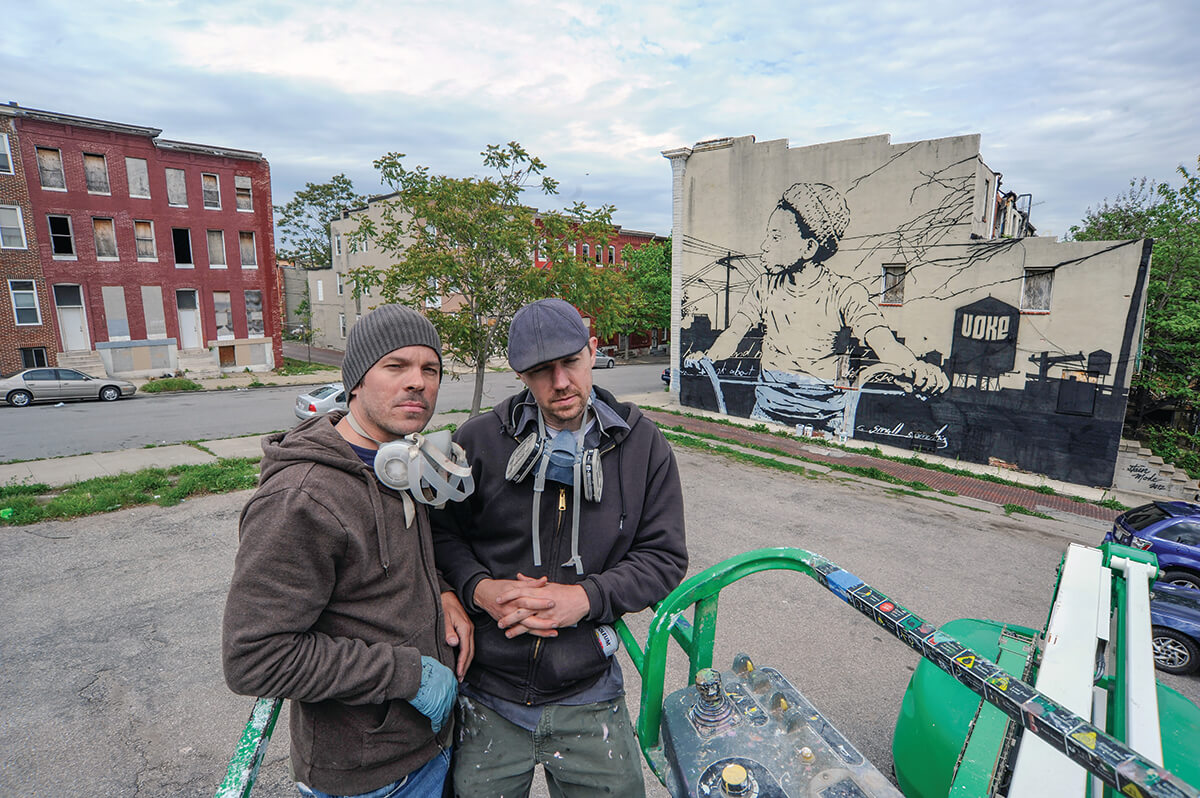Arts & Culture
Artist Chris Stain is Documenting the History of Graffiti in Baltimore
Stain contributed to the city’s acclaimed 2012 Open Walls project.

“The first tag I did was with a marker on the side door of John’s Quality Bakery at Fairmont and Kenwood. I had a red El Marko, and just wrote my name and it wasn’t big and I was nervous and scribbled it on real quick,” recalls Chris Stain. “But then I felt all kinds of things at once and a rush of adrenaline. The first thing I did with spray paint was up the block from where I lived. I had one of those old Testors cans that you use for painting model cars, and I wrote my name on the corner house. In a very juvenile sense, I felt immortal, and this great sense of purpose like I’d arrived at something.”
All of 11 years old, Stain had arrived at his life’s work. In high school, he learned printmaking before shifting his technique toward stenciling. Self-taught, he also moved toward paperwork and public murals, which he’s done all over the world. His efforts have been shouted out in publications from Graffiti World to The New York Times and shown in galleries from Baltimore and New York to Berlin, London, and Amsterdam.
Now 50, with two children, he’s a member of the United Scenic Artists Local 829 in New York. With down time due to the actors’ and writers’ strikes (he’d been making sets for an HBO revival of Pretty Little Liars), he’s currently working on a commissioned proposal for CFG Bank Arena.
Earlier this summer, Stain put a collection of ’80s skateboarding and graffiti images into a limited edition, 4×6-inch photo album project titled Highlandtown Refugee. But his larger, still-in-development plan is a book chronicling the early history of graffiti in Baltimore, which he saw explode firsthand.
Baltimore’s first graffiti artist, according to Stain, was not a style writer in the usual sense, but an older Black worker, reportedly employed by either Bethlehem Steel or the city, who went by BEAU.
“He wrote with marking pens, which steelworkers used to identify pieces of steel, that look like tubes of toothpaste,” Stain says, adding that at least one BEAU tag remains visible. “He was not part of any movement like the teenagers in the late 1970s and early ’80s. Then a guy who went by REVOLT came from Manhattan to attend the Maryland Institute College of Art and he wrote on things that got attention, as did several kids who attended the Baltimore Experimental High School,” which tended to attract independent, creative, and dysfunctional students in equal measure. “One kid’s tag was CUBA. Another wrote DILLINGER. They were all part of the punk scene at a club everyone called The Loft.”
The first time graffiti really hit Stain, he was walking to school at St. Elizabeth’s. In the alley behind the bakery where he grabbed pizza rolls to take for lunch, a massive, colorful tag had suddenly appeared. “I went to class but kept thinking about it. A few days later, on a school building, I saw another big graffiti piece and I thought, ‘What is this? Who did it? Why is it popping up?’”
That summer of 1984, the movie Beat Street, about a break-dancer, a graffiti writer, and a hip-hop DJ in the Bronx, offered an explanation. Just a sixth-grader, Stain realized hip-hop culture had made it to Baltimore because he’d seen older kids trying to break-dance. He remembers leaving the since-demolished Grand Theatre in Highlandtown and racing home to draw graffiti lettering from the movie. “I played soccer. I rode bikes. I skateboarded. Nothing affected me like seeing that artistic expression being done by other kids.”
In his research, Stain, who was arrested at 11, 16, and, yes, 39 for tagging, has found police photographs of local graffiti from that era. Following in the footsteps of Philadelphia, Baltimore eventually launched some mural initiatives as part of its anti-vandalism efforts and Stain later contributed to the city’s acclaimed 2012 Open Walls project (see opening image, which shows Stain on the right with artist Billy Mode).
“It’s not in the public’s best interest to have kids writing graffiti and painting on people’s property. But sociologically there is a reason why kids do the things that they do,” Stain says. “At the heart of it, it’s a need to be heard, to be seen. It can seem perverted because what you’re doing is seen as defacing other people’s property, but it’s also the world we live in and that’s what I’m trying to figure out by putting the book together: how somebody survives with all the madness that’s going on around them.”
When he was growing up, says Stain, whose father got laid off from Western Electric, forcing the family to move, a kid could make more money selling drugs and guns in Patterson Park than some of their parents made.
“Some people turn to alcohol and drugs, some people turn to sports, some people turn to art as a means of survival,” he continues. “I got lucky. I don’t know how else to describe it. I never thought art would be a career. I figured I’d get a construction or blue-collar job and art would just be my hobby, the thing that kept me getting up every day.”
Above: A collection of early ’80s graffiti pieces from PLAD, DILLINGER, and TRASH 1. —Courtesy of Chris Stain.
![plad1[1]](https://www.baltimoremagazine.com/wp-content/uploads/2023/10/plad11.jpg)
![TAKE5byREVOLT[1]](https://www.baltimoremagazine.com/wp-content/uploads/2023/10/TAKE5byREVOLT1.jpg)
![trash1[1]](https://www.baltimoremagazine.com/wp-content/uploads/2023/10/trash11.jpg)
![ZEK1983[1]](https://www.baltimoremagazine.com/wp-content/uploads/2023/10/ZEK19831.jpg)
![ZEROMEO[1]](https://www.baltimoremagazine.com/wp-content/uploads/2023/10/ZEROMEO1.jpg)
![americabyEVER[1]](https://www.baltimoremagazine.com/wp-content/uploads/2023/10/americabyEVER1.jpg)
![ANOKLOFT[1]](https://www.baltimoremagazine.com/wp-content/uploads/2023/10/ANOKLOFT1.png)
![CUBA80s[1]](https://www.baltimoremagazine.com/wp-content/uploads/2023/10/CUBA80s1.jpg)
![kruz157GSI[1]](https://www.baltimoremagazine.com/wp-content/uploads/2023/10/kruz157GSI1.jpg)
![QUEST[1]](https://www.baltimoremagazine.com/wp-content/uploads/2023/10/QUEST1.jpg)
![mirage_two_85[1]](https://www.baltimoremagazine.com/wp-content/uploads/2023/10/mirage_two_851.jpg)